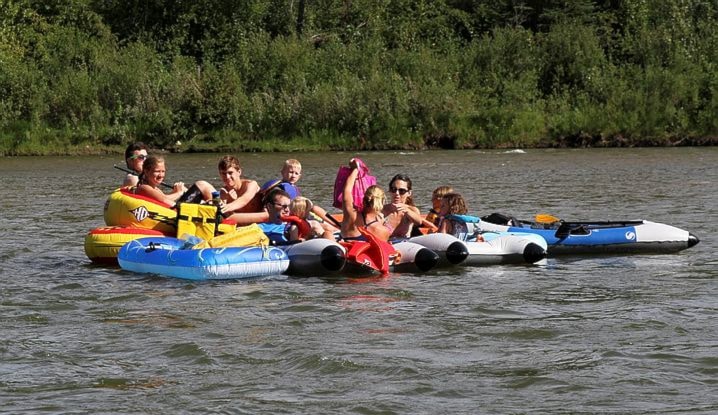Some foolhardy Central Albertans have floated down the Red Deer River on flimsy, plastic blow-up mattresses, wearing nothing but their bathing suits.
Others have drifted for miles downstream while straddling rubber tires, with no oars or life-jackets in sight.
One party-hardy group was all set to hit the river while seated around the sides of a round rubber dinghy — its centre loaded with ice and beer cans, recalled Bob Dixon, Red Deer County’s senior patrol officer.
“There are a dozen recipes for disaster . . . People have no idea . . . ” added Dixon, who admitted he has pretty much seen it all when it comes to folks failing to have foresight, or observe water safety rules.
Each sunny summer weekend, patrolling county peace officers give out warnings and $115 liquor fines and some people still think they can sneak alcohol onto their boats or rafts.
Under the Provincial Gaming and Liquor Act, consuming alcohol in public places — including while floating down a river — is prohibited.
“Usually we try to educate people to get them to comply,” said Dixon.
But peace officers have come across boating parties who have already consumed copious amounts of beer while still in the parking lot.
Since this makes them less than lucid before even getting to the river, these people are usually slapped with fines, added Dixon.
“You’re not making good decisions if you have consumed alcohol or have heat stroke” — which brings him to the subject of preparedness — or lack there of.
Too many people get into a boat or raft with just the clothing on their back, which might consist of a bathing suit or skimpy shorts and a T-shirt, with shoes and life-jackets seemingly considered optional.
Actually, Dixon said life-jackets must be carried at all times. “A lot of people don’t realize that when you get on a raft on the river, this is considered a vessel and you are supposed to have life-jackets with you, along with safety gear,” including signalling devices.
Being a strong swimmer won’t matter if you get pulled underwater by an undertow and get snagged on log, he added, noting that the river bottom changes configuration after each spring of high water flow. Sections of the river that used to be shallow can get carved deeper by debris.
“You may have rafted down the river 100 times, but each time is a different experience.”
Dixon also urges that sturdy vessels be used for river trips. Hidden debris or rocks can easily tear flimsy water mattresses, he added, and the next thing you know you are stuck on an island waiting for rescue — or seeking help at a farmhouse after trekking across a field.
Innisfail RCMP, the county fire department and technical rescue team were all involved in a search for five 12-14 age girls who got lost while floating down the river last week from Red Lodge Provincial Park near Bowden. The girls turned up some eight hours after they disappeared, having to walk back to the park without proper footwear.
Dixon believes that they, like many tubers, couldn’t recognize their bearings from the perspective of the river and overshot the park limits.
A lot of boaters also seriously underestimate the amount of time it takes to get from point A to point B on the river.
When the flow slows after spring snow has melted, vessels might only float at a rate of a few kilometers an hour down the Red Deer River. “If you need to go down the river three or four miles, and you’re only going one to two miles and hour, it will take you two to three hours to get there,” said Dixon, who has known people who have had to travel six to eight hours to get to their pickup destinations.
That’s a lot of time to be cooking in the direct sun, which intensifies around water.
Dixon said he can’t stress enough the need to bring sunscreen and plenty of drinking water on river trips — as well as a hat and extra clothing that allows you to cover up.
Heat stroke and dehydration can sometimes be serious enough to require hospitalization, added Dixon, who would like Central Albertans to think ahead and enjoy safe trips down the river, so that emergency resources are only used for true emergencies.
lmichelin@www.reddeeradvocate.com
